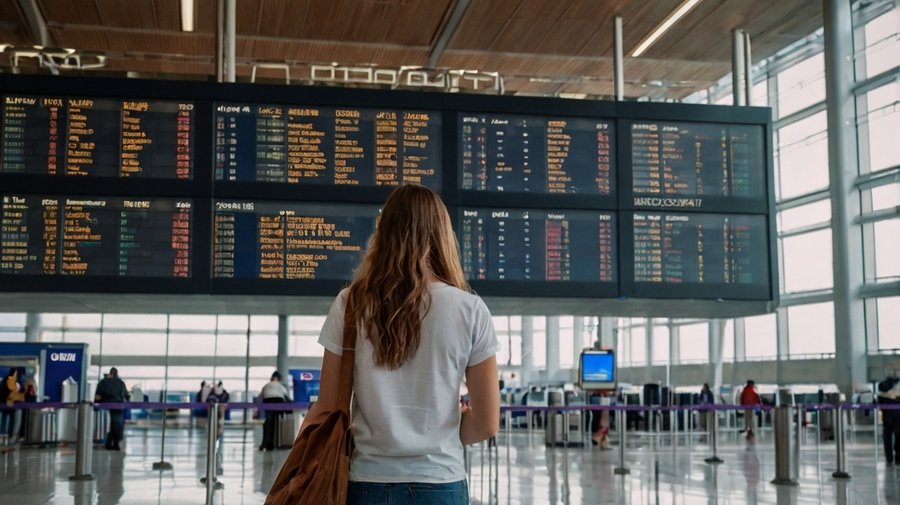Flight Buzz
Over 400 Flights Cancelled Across Asia Amid Severe Weather, Disrupting Travel at Major Airports such as Shanghai, Tokyo International, Affecting Airlines including Singapore, ANA, Air China, Emirates, and More

Wednesday, July 30, 2025
Severe weather conditions have wreaked havoc across Asia, causing widespread flight cancellations and delays at major airports, including Shanghai Pudong, Beijing Capital, Hong Kong International, and Tokyo Haneda. Over 400 flights have been cancelled, and hundreds more delayed, as powerful storms continue to disrupt air travel. Airlines such as Singapore Airlines, ANA, Air China, Emirates, Japan Airlines, and Lufthansa have been particularly affected, with passengers stranded as airports struggle to manage the fallout. The storms have created a chaotic travel environment, leaving thousands of travelers in uncertainty as they await updates, with the extreme weather conditions showing no signs of abating.
With Over 400 cancellations and hundreds of delays at major airports. Shanghai Pudong saw 179 cancellations (18%) and 539 delays (25%), primarily affecting China Eastern and China Southern. Beijing Capital reported 21 cancellations (1%) and 386 delays (32%), with Air China and China Eastern most impacted. Tokyo Haneda had 2 cancellations (1%) and 161 delays (12%), mainly with ANA and Japan Airlines. Hong Kong International faced 4 cancellations (3%) and 158 delays (16%), affecting Cathay Pacific and Air China. Singapore Changi recorded 1 cancellation (0%) and 161 delays (25%), with Air Asia and Cathay Pacific affected. Shanghai Hongqiao had 103 cancellations (18%) and 250 delays (23%), while Guangzhou Baiyun saw 34 cancellations (4%) and 768 delays (55%), with China Eastern and China Southern the hardest hit. Suvarnabhumi Bangkok reported 4 cancellations (3%) and 156 delays (11%), with Spring Airlines and China Airlines impacted. Chatrapati Shivaji had 1 cancellation (1%) and 59 delays (5%), while Jinan Yaoqiang recorded 2 cancellations (2%) and 124 delays (27%). Chengdu Shuangliu faced 22 cancellations (12%) and 186 delays (33%), while Sendai had 34 cancellations (49%) and 5 delays (1%). Nantong reported 26 cancellations (50%) and 17 delays (16%), and Hangzhou Xiaoshan had 24 cancellations (5%) and 516 delays (40%). Changsha Huanghua saw 17 cancellations (8%) and 207 delays (34%). These disruptions are impacting major airlines and causing delays across the region as severe weather continues.
Flight Cancellations and Delays Across Major Asian Airports
The ongoing severe weather conditions have heavily impacted air travel across several key hubs. Shanghai Pudong International Airport, one of the busiest airports in Asia, reported 179 cancellations and 539 delays. Airlines such as China Eastern, Spring Airlines, and Shanghai Airlines were hit hardest, with significant numbers of cancellations and delays affecting both domestic and international travelers. Other carriers, including China Southern Airlines and Juneyao Airlines, also faced disruptions. Travelers are advised to check with their airlines for updates and to expect extended wait times.
At Beijing Capital International Airport, there were 21 cancellations and 386 delays, with Air China being the most affected carrier, accounting for a large portion of both the cancellations and delays. China Eastern and Hainan Airlines also reported disruptions, although to a lesser extent. Passengers flying through Beijing are urged to remain patient, as weather conditions are expected to continue impacting flight schedules.
Tokyo Haneda International Airport, a major hub in Japan, reported 2 cancellations and 161 delays. ANA (All Nippon Airways) and Japan Airlines experienced the highest number of delays, with some international airlines like Delta also reporting cancellations. While the number of cancellations was relatively low, the delays still caused significant inconvenience for travelers, particularly on flights to and from other Asian destinations.
Hong Kong International Airport saw 158 delays and 4 cancellations, with Cathay Pacific being the most affected airline. Other carriers, such as China Eastern and Air China, also faced delays, further complicating travel plans for passengers. With Hong Kong being a major transit point for international flights, these disruptions have had a ripple effect on air travel across the region.
Singapore Changi Airport, another important regional hub, reported 161 delays and a single cancellation. Air Asia was notably impacted, with many of its flights delayed, while other carriers, including China Eastern and Cathay Pacific, experienced significant delays as well. Passengers at Changi are advised to check for real-time updates and prepare for potential delays.
Shanghai Hongqiao International Airport, which handles domestic flights, reported 103 cancellations and 250 delays. China Eastern Airlines and China Southern Airlines experienced the highest levels of disruption, with Shanghai Airlines and Spring Airlines also seeing delays. This has led to a crowded terminal and long wait times for affected passengers.
Guangzhou Baiyun International Airport, a major airport in southern China, saw 34 cancellations and 768 delays. China Eastern Airlines and China Southern Airlines were the most impacted, with several other carriers, including Air China and Shenzhen Airlines, reporting delays as well. The scale of the disruption has left many passengers frustrated, especially those on connecting international flights.
Suvarnabhumi Bangkok International Airport in Thailand saw 156 delays and 4 cancellations. Spring Airlines and China Airlines were among the most affected carriers, while Thai Airways and Air Asia also reported several delays. The situation at Bangkok’s airport has led to a higher-than-usual number of travelers stranded at the airport, especially for those with connecting flights to other parts of Asia.
At Chatrapati Shivaji International Airport in Mumbai, the disruptions were comparatively minor, with 59 delays and just 1 cancellation. However, airlines like Akasa Air and Air India were among those reporting delays. Passengers are encouraged to stay in contact with their respective airlines for rebooking options and to check for real-time updates.
Jinan Yaoqiang International Airport, a smaller airport in China, reported 2 cancellations and 124 delays. China Eastern Airlines and Shandong Airlines were the most affected, with several other regional carriers also experiencing disruptions. Travelers flying through Jinan should expect limited options for rebooking and should check for updates on affected flights.
Chengdu Shuangliu International Airport in Sichuan province experienced 22 cancellations and 186 delays. Air China and China Eastern Airlines were the most impacted, with Sichuan Airlines also reporting several delays. The disruptions have affected both domestic and international routes, adding to the already challenging situation at the airport.
Sendai Airport in Japan faced a relatively minor disruption, with 5 delays and 34 cancellations. Ibex, Japan Airlines, and ANA Wings were the most affected, while Skymark Airlines also reported delays. Despite the fewer delays, travelers should be prepared for potential complications and should stay updated with their flight statuses.
Nantong Airport, a smaller airport in China, reported 26 cancellations and 17 delays. Donghai Airlines, Air China, and Shenzhen Airlines were the most impacted by the weather. Passengers at Nantong are advised to check for flight updates regularly to avoid any unnecessary wait times.
Hangzhou Xiaoshan International Airport, located in eastern China, saw 24 cancellations and 516 delays. China Eastern Airlines and Air China faced the highest number of delays, with Shandong Airlines and Shenzhen Airlines also reporting significant disruptions. As a major domestic hub, Hangzhou has seen considerable impact on domestic flights, and passengers are urged to check for real-time information before traveling to the airport.
Finally, Changsha Huanghua International Airport reported 207 delays and 17 cancellations. China Eastern Airlines and Shanghai Airlines were the most affected, with other carriers such as China Southern Airlines and Shandong Airlines also experiencing delays. The weather conditions have caused significant travel disruption in central China, with passengers advised to monitor their flight statuses closely.
Regional Impact in Southeast Asia and Beyond
The disruption caused by the severe weather extended to several other major airports across Southeast Asia. Suvarnabhumi Airport in Bangkok reported 156 delays and 4 cancellations, with Thai Airways, AirAsia, and China Airlines experiencing significant operational delays. Other airports in the region, such as Kuala Lumpur International and Manila Ninoy Aquino, also faced moderate disruptions as travelers were caught in the ripple effects of these widespread weather disturbances.
Severe weather across Asia has led to the cancellation of over 400 flights at major airports, including Shanghai Pudong, Tokyo Haneda, and Hong Kong International, with airlines like Singapore, ANA, Air China, and Emirates heavily impacted by ongoing storms disrupting travel.
Airline Responses and Passenger Frustration
Airlines have advised passengers to check the status of their flights frequently and to get to the airport even earlier than normal. Several carriers, China Eastern, Cathay Pacific and Singapore Airlines among them, have adopted rebooking and refund policies to aid affected passengers. But the small number of available seats on rebooked flights and enormous demand has meant long delays for many passengers in getting rebooked on other flights.
The customer service centers in the region are jammed with calls, and many travelers have turned to social media to vent, sharing images of packed terminals and imploring for help. Airlines have tried to add staff and alternatives, but the overcapacity of disruptions has left many passengers unsure about their travels.
With storm systems tracking through the area, the question is how long the delays and cancellations will last. Travellers should also check airlines and airports for the most current information.
Flight Buzz
Hawaiian Airlines launches ‘Sip and Soar Sweepstakes’ to celebrate local travel and culinary excellence : Maui Now

August 2, 2025, 4:00 PM HST
Hawaiian Airlines, in partnership with Sheraton Maui Resort & Spa and the Hawai‘i Food & Wine Festival, is inviting kamaʻāina to rediscover the beauty and flavors of West Maui through its new Sip & Soar Sweepstakes. The campaign, running through Aug. 31, offers Huakaʻi by Hawaiian members an exclusive chance to win an unforgettable Maui getaway.
The sweepstakes is part of Hawaiian Airlines’ ongoing commitment to supporting local travel and community events. One lucky winner will receive a Maui staycation package valued at $3,550, which includes:
- Two roundtrip neighbor island flight on Hawaiian Airlines
- A two-night oceanfront stay at the Sheraton Maui Resort & Spa
- Two priority access tickets to the “World of Wagyu, Wine & Whiskey” at the 15th Annual Hawai‘i Food & Wine Festival on Oct. 25 in Kāʻanapali
“This sweepstakes is our way of encouraging kamaʻāina, through our Huakaʻi by Hawaiian program, to reconnect with and support the vibrant community of West Maui,” said Alisa Onishi, managing director of Hawai‘i marketing at Hawaiian Airlines. “We’re honored to partner with Sheraton Maui and the Hawai‘i Food & Wine Festival to help spotlight the incredible culture, cuisine, and hospitality that make Maui so special.”
To enter, Hawai‘i residents must be 21 years or older and enrolled in Huakaʻi by Hawaiian by Aug. 31, 2025. Membership is free and offers exclusive benefits such as quarterly fare discounts, one free checked bag on interisland flights and access to special promotions.
All eligible Huakaʻi by Hawaiian members will be automatically entered into the sweepstakes. The winner will be notified via email and must accept the prize and applicable tax responsibilities.
For official rules and eligibility, visit HawaiianAirlines.com/OfficialRules.
Flight Buzz
ITA Airways Cancels Flights To Israel Amid Rising Tensions And Security Warnings

Sunday, August 3, 2025
In a major move affecting international air travel, ITA Airways, Italy’s national carrier, has announced the suspension of all flights from Italy to Israel until October 1, 2025. This decision comes as a response to the rising security situation in Israel. The ongoing conflict between Israel and Hamas has driven this precautionary measure. Many travelers now find themselves uncertain about their plans and must reconsider their flight options to and from Tel Aviv, Israel’s main international gateway.
ITA Airways, a member of the Lufthansa Group and the Star Alliance, shared this announcement through its official channels. The airline stated that the suspension stems from safety concerns for passengers and crew amid the unstable situation. While these measures aim to ensure safety, they also expose the broader challenges international airlines face when political or security issues arise.
Impact on Travelers: Stranded Passengers and Uncertainty
The suspension of flights from Italy to Israel has disrupted travel plans for many individuals and families who were set to fly between the two countries. Travelers with existing bookings should contact ITA Airways directly for updates on rebooking options or refunds. The airline has committed to helping affected passengers and is working closely with relevant authorities to address the situation.
The uncertainty surrounding the flight suspension shows the challenges international travelers encounter when political instability disrupts air travel. Passengers are encouraged to stay informed by regularly checking the airline’s updates and any travel advisories from official government sources. Those planning to travel to Israel in the coming months need to be flexible with their plans, as the situation can change based on security developments.
Broader Implications for International Air Travel
ITA Airways’ choice to suspend flights signals a growing trend among international airlines reassessing their operations in the Middle East over safety concerns. Several other airlines have altered their schedules or suspended services to Israel in recent months, citing similar risks.
The impact of such suspensions extends beyond tourism or business travel. It also affects diplomatic and cultural exchanges between countries. Israel and Italy have enjoyed a long-standing relationship, with many tourists and business professionals traveling between the two nations each year. The lack of direct flights creates a ripple effect that impacts various sectors, including hospitality, tourism, and trade.
For ITA Airways, the suspension is not just a temporary inconvenience for travelers; it could have long-lasting effects on tourism between Italy and Israel. For many, Israel has been a popular destination for historical and cultural tourism, especially for those interested in Jerusalem’s ancient sites, the Dead Sea, and the region’s religious significance. With flights suspended, there are concerns that tourism may slow down until security conditions improve.
Looking Ahead: Flexible Travel Options and Future Updates
While the flight suspension is expected to last until October 1, 2025, ITA Airways has stressed that they will regularly review the situation based on the security environment in Israel. The airline remains committed to passenger safety and will continue to monitor developments, providing updates as needed. It is also anticipated that flights to Israel will resume in phases once the security situation stabilizes.it
Travelers who planned to visit Israel should think about alternative routes or destinations for now. Many airlines offer connections to Israel through other European hubs like Frankfurt, London, or Paris. Some may also find it worthwhile to consider other Middle Eastern countries, such as Jordan or Egypt, which also boast rich cultural and historical significance and are relatively close to Israel.
Preventative Measures: Airline Responsibility and Passenger Safety
The flight suspension raises questions about the responsibility of airlines in facing global security threats. Airlines often temporarily halt or adjust their flight schedules in response to areas of conflict or places where risks of violence are high. In these situations, airlines must prioritize the safety of their passengers and staff. ITA Airways’ actions remind us how sensitive airline operations can be to changing geopolitical conditions.
As travel continues, passengers are encouraged to stay informed about security conditions in the region, consult official government travel advisories, and know their rights in case of a flight cancellation. Understanding passenger safety protocols and exploring insurance options can also offer travelers peace of mind during disruptions.
Conclusion: Managing Travel Amidst Uncertainty
The suspension of ITA Airways flights to Israel highlights the challenges airlines face when political instability disrupts travel plans. While the decision is mainly based on safety concerns, it underscores the complexities of air travel in unstable regions. For affected travelers, flexibility and patience are essential as they navigate the uncertainty of their future travel plans. As the security situation changes, airlines like ITA Airways will likely adjust their operations to ensure passenger safety, providing updates as new developments arise.
For now, passengers intending to travel to Israel from Italy should look into alternative routes or destinations and stay updated on flight operations. With global travel becoming more interconnected, the ability to adapt to unexpected circumstances remains crucial for ensuring safe and smooth travel experiences for all.
(Source: ITA Airways, Israel flight cancellations, flight suspensions, travel advisory, airline disruptions, international air travel, security concerns, Israel tourism)
Flight Buzz
Azerbaijan, Kazakhstan and Uzbekistan Open a New Chapter in Travel With Direct Flights, Visa-Free Entry, and Festival Tourism

Sunday, August 3, 2025
Azerbaijan, Kazakhstan, and Uzbekistan are reshaping the travel landscape in Central Asia by launching a new era of regional tourism defined by convenience, culture, and collaboration. With direct flights now linking key cities, visa-free entry easing cross-border movement, and a growing calendar of coastal festivals and cultural events, travelers from these three nations are enjoying easier, richer, and faster access to each other’s destinations. This new chapter in travel isn’t just about numbers—it’s about connection. Whether it’s a beachside music festival on the Caspian coast or a weekend getaway in the heart of Baku, the region is opening up in ways that are bringing people—and possibilities—closer than ever before.
Rather than casting a wide net globally, the country is strategically deepening regional ties to boost its tourism sector—reviving momentum lost during the global shutdown and laying new paths for future growth.
From Baku to Basqal, Familiarization Tours Show Off Azerbaijan’s Diversity
To showcase its offerings firsthand, Azerbaijan recently welcomed tourism representatives from Kazakhstan and Uzbekistan on a curated familiarization journey. The route led them through the cobbled streets of Baku’s historic core, into the tranquil villages of the Shamakhi highlands, and onward to Caspian beach resorts—each destination revealing a different face of the country’s tourism potential.
Along the coast, guests were treated to one of the season’s most anticipated cultural events—a music and lifestyle festival held steps from the sea. Combining regional talent with an open-air setting, the event struck a chord with visitors from neighboring countries, offering an experience that felt both exclusive and culturally familiar.
Tourism Industry Connects Regionally Through New Business Collaborations
To convert interest into long-term partnership, a regional tourism networking session followed the tour. Dozens of Azerbaijani hospitality brands, tour agencies, and resort operators sat down with Central Asian travel companies in a business-to-business format. The goal? Forge deeper ties, co-create travel packages, and open new promotional channels across borders.
This direct engagement with the industry helps ensure that Central Asian visitors aren’t just welcomed—they’re offered experiences and itineraries that feel tailor-made. It’s a smart approach, placing regional cooperation at the center of Azerbaijan’s tourism strategy.
Visitor Surge Signals New Momentum
Recent tourism figures show that this effort is bearing fruit. During the first six months of the year, Azerbaijan recorded over 68,000 tourist arrivals from Kazakhstan and Uzbekistan—marking a 15% rise compared to the same stretch last year. The numbers reflect a growing appetite for nearby, visa-free travel among Central Asian citizens, as well as rising awareness of Azerbaijan as a multi-season destination.
Thanks to improved air connectivity, traveling to Baku now takes less than three hours from many Central Asian cities. Multiple carriers are now operating direct routes from four Kazakh cities and two Uzbek hubs. For travelers seeking spontaneous weekend trips or short family vacations, this connectivity has made Azerbaijan both practical and desirable.
A Caspian Sea Ferry Project Hints at Future Mobility
Looking ahead, regional mobility may extend beyond air routes. Plans are being explored for a high-speed passenger ferry connecting the Kazakh port city of Aktau with Baku across the Caspian Sea. If developed, the service would not only offer scenic passage but also reinforce a historical link between the two regions—turning the sea into a corridor for tourism and commerce.
This waterway connection could create fresh possibilities for cross-border exploration, opening up multi-destination travel circuits across the Caspian basin.
Tourism Recovery Rides on Strategic Long-Term Vision
The recent regional push reflects a long-term vision that began years ago. In a bold move to rebrand its image, Azerbaijan launched a global marketing campaign in 2018 designed to reposition the country as a must-visit destination. Part of that strategy included opening overseas offices in key international markets and designing a new tourism identity that emphasized its cultural richness, landscapes, and modern appeal.
Before the pandemic struck, those efforts had started to pay off. The country welcomed over 3 million international visitors in 2019—its best tourism year on record. However, like nearly all destinations, Azerbaijan faced a steep drop in arrivals in 2020, as border closures and travel bans took their toll.
Rather than wait for global travel to bounce back, Azerbaijan is taking a proactive stance—starting with the travelers who are just a few hours away.
Conclusion: A Reimagined Tourism Future Begins at Home
Azerbaijan is tapping into something many destinations overlook: the power of regional travel. By focusing on its neighbors—countries with cultural links, shared histories, and easy access—it’s setting a blueprint for recovery that doesn’t rely on long-haul flights or distant markets. Whether it’s a quick escape to the Caspian coast, a music-filled weekend in Baku, or a mountain retreat in the highlands, the country is crafting experiences that appeal directly to Central Asian travelers.
And with visa-free travel, direct routes, and expanding partnerships, this new chapter in Azerbaijani tourism is just getting started.
-

 Brand Stories2 weeks ago
Brand Stories2 weeks agoBloom Hotels: A Modern Vision of Hospitality Redefining Travel
-

 Brand Stories1 week ago
Brand Stories1 week agoCheQin.ai sets a new standard for hotel booking with its AI capabilities: empowering travellers to bargain, choose the best, and book with clarity.
-

 Destinations & Things To Do2 weeks ago
Destinations & Things To Do2 weeks agoUntouched Destinations: Stunning Hidden Gems You Must Visit
-

 Destinations & Things To Do1 week ago
Destinations & Things To Do1 week agoThis Hidden Beach in India Glows at Night-But Only in One Secret Season
-

 AI in Travel2 weeks ago
AI in Travel2 weeks agoAI Travel Revolution: Must-Have Guide to the Best Experience
-

 Brand Stories4 weeks ago
Brand Stories4 weeks agoVoice AI Startup ElevenLabs Plans to Add Hubs Around the World
-

 Brand Stories3 weeks ago
Brand Stories3 weeks agoHow Elon Musk’s rogue Grok chatbot became a cautionary AI tale
-

 Asia Travel Pulse4 weeks ago
Asia Travel Pulse4 weeks agoLooking For Adventure In Asia? Here Are 7 Epic Destinations You Need To Experience At Least Once – Zee News
-

 AI in Travel4 weeks ago
AI in Travel4 weeks ago‘Will AI take my job?’ A trip to a Beijing fortune-telling bar to see what lies ahead | China
-

 Brand Stories4 weeks ago
Brand Stories4 weeks agoChatGPT — the last of the great romantics













You must be logged in to post a comment Login